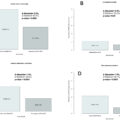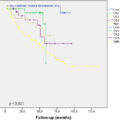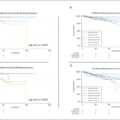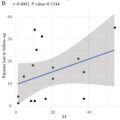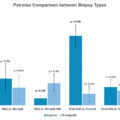Highlights
- •
Nephron-sparing surgeries after response to immunotherapy are feasible.
- •
These surgeries offer prolonged remissions and good functional results.
- •
These surgeries can be performed with limited morbidity.
- •
38.5% of patients had no residual tumor (ypT0) on final pathology.
- •
This highlights the need for early re-discussion in multidisciplinary tumor boards.
Abstract
Background
Complete responses to immunotherapy in metastatic kidney cancer have led to a renewed interest in primary-site surgery. The prolonged survival of these patients has prompted consideration for nephron-sparing surgery when technically feasible. Given the surgical difficulties reported in the literature, it is essential to assess the feasibility as well as functional and oncological results of partial nephrectomy (PN) after immunotherapy.
Methods
Multicentric retrospective study based on UroCCR database, including all metastatic patients who underwent PN after a complete response to immunotherapy at metastatic sites. Morbidity, renal function, positive margin rate, and oncological outcomes were assessed.
Results
Thirteen patients underwent PN after immune checkpoint inhibitor (ICI), between January 2019 and September 2023. Median age at surgery was 64 [50–68]; 84.6% received ICI as first-line treatment with a median duration of 11.7 [7.7–14.9] months. None of the patients had positive surgical margins, five patients (38.5%) were ypT0. Two patients (15.4%) presented intraoperative complications and 1 a severe postoperative complication. Median GFR at 3 months was 84.7 [66.6–95.2] mL/min/1.73 m2 with no significant difference from preoperative GFR. After surgery, immunotherapy was not reintroduced in ten patients (77%). Median follow- up was 25.6 [19.6–30.2] months, median treatment-free survival was 22.4 [15.8–34.7] months. RFS at 12 months and at last follow-up were 84.6% and 53.8%. OS rate at last follow-up was 92.3%.
Conclusion
This series demonstrates the feasibility of partial nephrectomy following immune checkpoint inhibitor treatment, with acceptable morbidity rates and no major difficulties specifically attributable to the prior treatment. While the data suggest promising functional and oncological outcomes, further investigation is needed. The study underscores the importance of early re-evaluation of metastatic cases in multidisciplinary tumor boards.
1
Introduction
Renal cell carcinoma (RCC) is the 14th most common cancer worldwide [ ]. Although it is most often diagnosed incidentally at a localized stage, on imaging performed for other causes [ ], it remains diagnosed at the metastatic stage in approximately 15% of the cases [ , ]. The management of these patients has considerably changed in recent years, leading to improvements in their overall [ ]. Since the CARMENA trial [ ], cytoreductive nephrectomy is no longer the standard of care for intermediate- or high-risk patients who now benefit from initial systemic treatment. With the introduction of immune checkpoint inhibitors (ICI), either combined with tyrosine kinase inhibitor (TKI) or dual ICI, the rate of complete radiological responses at the metastatic sites has increased. However, responses in the primary renal lesion are less frequently observed, renewing interest in surgical intervention for the primary lesion. The selection of patients eligible for nephrectomy and the true impact of this surgery on prognosis are still debated. Additionally, data on the complexity of these surgeries vary, with some authors reporting high levels of inflammation associated with immunotherapy (IO), suggesting more complicated procedures, whereas others have found no additional difficulties compared to patients who have not undergone systemic treatment [ , ].
Nevertheless, the extended survival of patients who are good responders to immunotherapy prompts consideration for nephron-sparing surgery whenever possible to achieve complete remission while preserving renal function.
Therefore, this study aims to describe the characteristics of patients eligible for delayed partial nephrectomy (PN) after immunotherapy, and to assess the feasibility, and functional and oncological outcomes of this surgical approach.
2
Materials and methods
2.2
Study population
Using the French Research Network on Kidney Cancer Database UroCCR (CNIL DR 2013-206; NCT03293563), we conducted a multicenter, retrospective study including all metastatic patients who underwent partial nephrectomy after a complete response to immune checkpoint inhibitors at metastatic sites.
2.3
Follow-up and outcomes
All preoperative, intraoperative, postoperative, and follow-up data were collected prospectively from the database after obtaining written consent.
Demographic data included patient age at surgery, sex, Body Mass Index (BMI), patient’s general condition (assessed by the Eastern Cooperative Oncology Group [ECOG] performance status), history of hereditary syndrome, indication for nephron-sparing surgery (NSS), description of metastatic sites, systemic treatment molecules, treatment line, and duration of systemic therapy before surgery. The response to ICI therapy was assessed using enhanced CT scans, and the primary tumor response was evaluated based on the percentage of reduction in tumor size.
Tumor characteristics included the diameter and complexity according to the RENAL score on the CT scan before surgery (classified as low [ ], moderate [ ] or high [ ]). The pathology report included the ISUP grade, tumor stage according to the 8th edition of the TNM classification system, and positive margin rate.
Morbidity was assessed in terms of the duration of surgery, estimated blood loss, blood transfusion rate, length of stay, and intra- and postoperative complications (considered minor if the Clavien-Dindo score was ≤2 and major if >2). The quality of the procedure was assessed using the Trifecta composite criteria [ ] combining negative surgical margins, absence of perioperative complications, and a decrease in GFR of less than 10% postoperatively.
Functional outcomes were assessed by measuring the serum creatinine level, estimating the GFR according to the Modification of Diet in Renal Disease (MDRD) formula pre- and postoperatively (at 3 months), looking for acute kidney injury (AKI), postoperative de novo chronic kidney injury (CKD), and CKD upgrade.
Follow-up was conducted according to the French Urological Association guidelines [ ], and oncological outcomes included recurrence-free survival (RFS), treatment-free survival (TFS) and overall survival (OS). OS was defined as time between surgery and death of any cause. RFS was defined as time between surgery and diagnosis of local recurrence, metastatic progression, or death of any cause, whatever comes first. TFS was defined as time between discontinuation of IO and resumption of treatment due to revolution.
2.3
Data analysis
Data analysis was performed using the R software environment for statistical computing and graphics (version 4.0.0). Continuous variables were reported as median and interquartile range [IQR], whereas categorical variables were reported as frequencies and proportions. A univariate logistic regression analysis was performed to identify potential predictive factors for achieving ypT0 status, representing the absence of residual tumor cells in pathological evaluations.
3
Results
3.1
Patients’ and surgeries’ characteristics
Out of 93 patients in our database who underwent cytoreductive surgery in the context of ICI therapy, 13 underwent PN after IO between January 2019 and September 2023. The median age at surgery was 64 [50–68] and 10/13 patients (77%) were male. At diagnosis, the prognostic group according to the International Metastatic RCC Database Consortium (IMDC) [ ] was favorable, intermediate, and poor for respectively 2/13 (15.4%), 7/13 (53.8%) and 4/13 (30.8%) patients. The median number of metastatic sites was 2 [1–3] and the median primary tumor size was 5.5 [3–7] cm. Most patients (11/13; 84.6%) received IO as first-line treatment with 4/13 patients (30.8%) treated using a combination ICI-TKI and 9/13 (69.2%) ICI in mono or dual therapy. The median duration of IO before surgery was 11.7 [7.7–14.9] months. The primary tumor site did not generally respond to treatment, since the median tumor size at surgery was 5.6 [5–6] cm corresponding to a median response of 0% [26.9 – -29.0]. The median RENAL score was 10 [8–10] ( Table 1 ).
| n=13 | |
|---|---|
| Age at surgery (years), median [IQR] | 64 [50–68] |
| Sex, n (%) | |
| Male | 10 (77) |
| Female | 3 (23) |
| Hereditary syndrome, n (%) | 0 (0) |
| BMI (kg/m2), median [IQR] | 29.2 [27.2–31.3] |
| ECOG performance status at surgery, n (%) | |
| 0 | 11 (84.6) |
| 1 | 2 (15.4) |
| IMDC prognostic group, n (%) | |
| Favorable | 2 (15.4) |
| Intermediate | 7 (53.8) |
| Poor | 4 (30.8) |
| Preoperative GFR (mL/min/1,73m2), median [IQR] | 88.0 [72.4–96.7] |
| Tumor size at diagnosis (cm), median [IQR] | 5.5 [3.0–7.0] |
| cT stage, n (%) | |
| cT1a | 4 (30.8) |
| cT1b | 5 (38.5) |
| cT2a | 1 (7.7) |
| cT3a | 3 (23.1) |
| Number of metastatic sites, median [IQR] | 2 [1–3] |
| Metastatic sites at diagnosis, n (%) | |
| Lung | 7 (53.8) |
| Bone | 7 (53.8) |
| Lymph nodes | 6 (46.2) |
| Liver | 1 (7.7) |
| Pancreas | 1 (7.7) |
| Treatment, n (%) | |
| Nivolumab + Ipilimumab | 6 (46.2) |
| Nivolumab | 3 (23.1) |
| Nivolumab + Ipilimumab + Cabozantinib | 2 (15.4) |
| Pembrolizumab + Axitinib | 1 (7.7) |
| Nivolumab + Axitinib | 1 (7.7) |
| Treatment duration (months), median [IQR] | 11,7 [7.7–14.9] |
| Line of treatment, n (%) | |
| First line | 11 (84.6) |
| 2nd line | 1 (7.7) |
| 3rd line | 1 (7.7) |
| Tumor size at surgery (cm), median [IQR] | 5.6 [5.0–6.0] |
| Tumor complexity at surgery, n (%) | |
| Low | 0 (0) |
| Intermediate | 6 (46.2) |
| High | 7 (53.8) |
Three patients (23.1%) had an imperative indication for PN, 1 (7.7%) underwent open surgery, and the others underwent surgery using a minimally invasive approach. The median operating time was 180 min [167–268]. The median estimated blood loss was 400cc [300–937.5] and 2/13 patients (15.4%) presented intraoperative complications (a vena cava injury sutured without requiring conversion to open surgery and an injury to the gall bladder in a patient undergoing quadruple tumorectomy). The median length of stay was 3 days [ ] and 4/13 patients (30.8%) developed postoperative complications, including 1/13 (7.7%) severe complication (urinary fistula requiring ureteral stenting and radiological drainage) ( Table 2 ).
| n=13 | |
|---|---|
| Indication for nephron-sparing surgery, n (%) | |
| Imperative | 3 (23.1) |
| Relative | 1 (7.7) |
| Elective | 9 (69.2) |
| Multiple tumorectomy, n (%) | 1 (7.7) |
| Surgical approach, n (%) | |
| Open | 1 (7.7) |
| Laparoscopic | 1 (7.7) |
| Robot-assisted | 11 (84.6) |
| Operating time (min), median [IQR] | 180 [167–268] |
| Blood loss (mL), median [IQR] | 400 [300–937.5] |
| Blood transfusion, n (%) | 1 (7.7) |
| Intraoperative complications, n (%) | 2 (15.4) |
| Postoperative complications, n (%) | 4 (30.8) |
| Including severe (Clavien ≥3) | 1 (7.7) |
| Length of stay (days), median [IQR] | 3 [3–6] |
| Trifecta satisfied, n (%) | 8 (61.5) |
Stay updated, free articles. Join our Telegram channel

Full access? Get Clinical Tree




